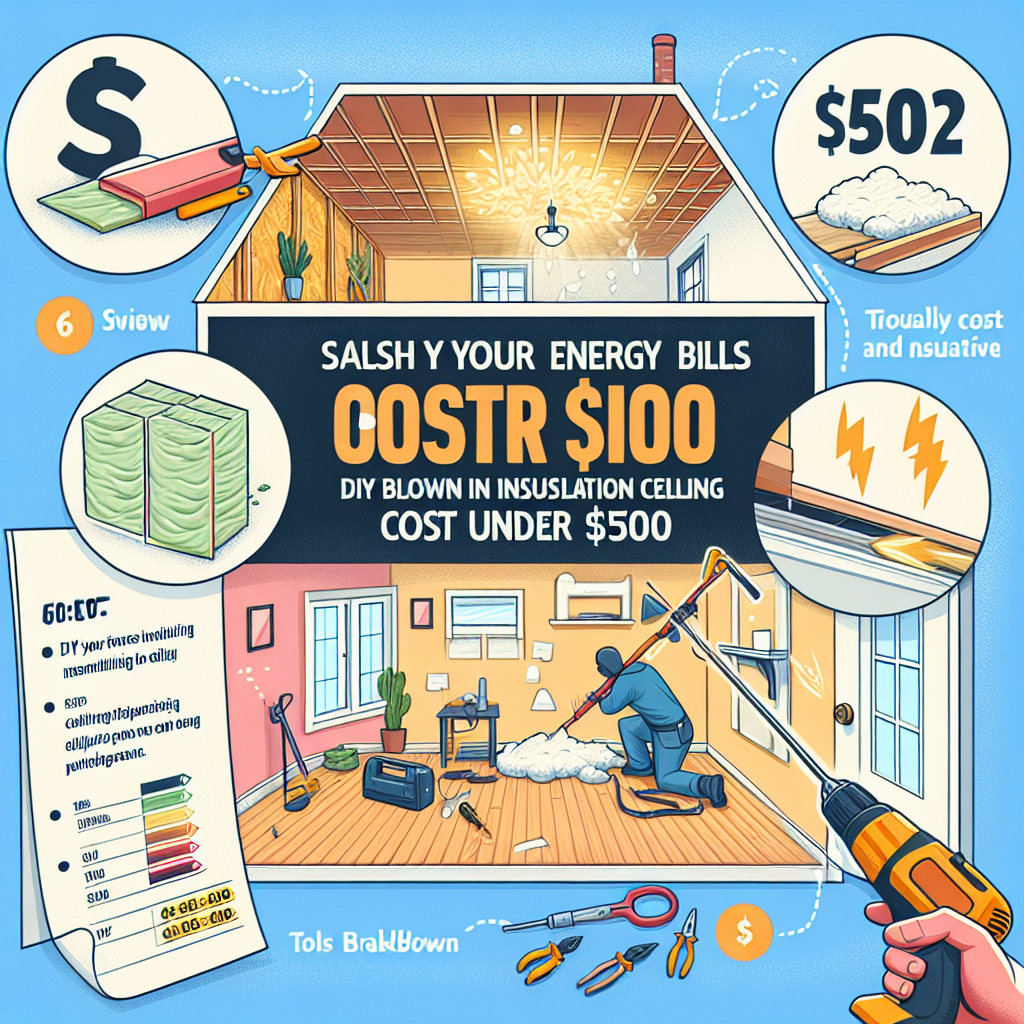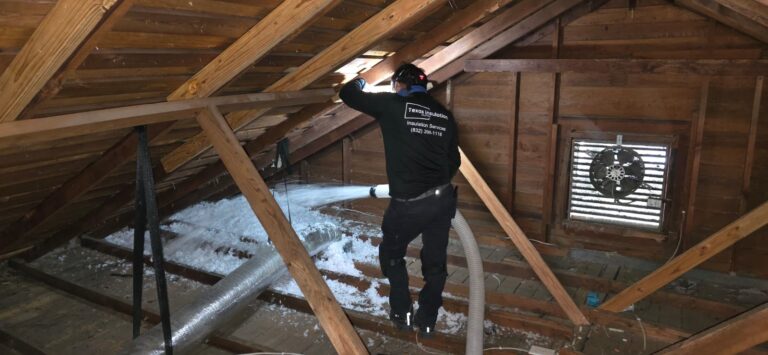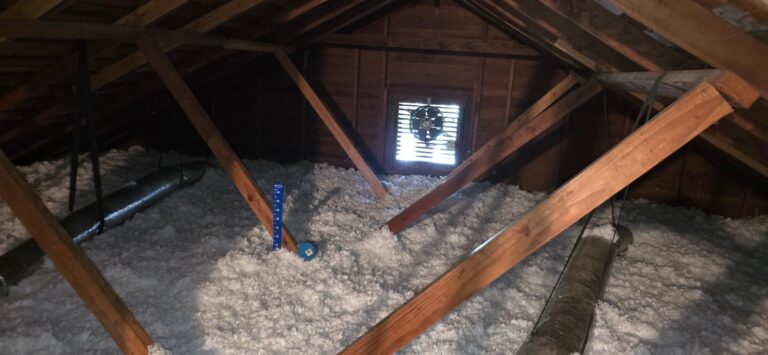-
Table of Contents
“Effortlessly insulate your ceiling with DIY blown-in insulation – the smart choice for a comfortable and energy-efficient home.”
Introduction
DIY blown-in insulation for ceilings is a cost-effective and efficient way to improve the energy efficiency of your home. This type of insulation involves using a machine to blow loose insulation material, such as fiberglass or cellulose, into the ceiling space. It can be a great option for homeowners looking to save money on their energy bills and increase the comfort of their living space. In this guide, we will discuss the benefits of DIY blown-in insulation for ceilings and provide step-by-step instructions on how to install it yourself.
The Benefits of DIY Blown In Insulation for Your Ceiling
Insulating your home is an important step in creating a comfortable and energy-efficient living space. While most people are familiar with traditional insulation methods such as batts or rolls, there is another option that is gaining popularity – DIY blown in insulation for your ceiling. This method involves using a machine to blow loose insulation material into your ceiling, creating a thick layer of insulation that can provide numerous benefits for your home. In this article, we will explore the benefits of DIY blown in insulation for your ceiling and why it may be a worthwhile investment for your home.
One of the main benefits of DIY blown in insulation for your ceiling is its ability to provide superior insulation. Unlike traditional methods, blown in insulation can fill in all the nooks and crannies of your ceiling, creating a seamless layer of insulation. This means that there are no gaps or spaces for air to escape, resulting in better temperature control and energy efficiency. In fact, blown in insulation has been shown to have a higher R-value (a measure of insulation’s effectiveness) compared to traditional methods, making it a more efficient choice for your home.
Another advantage of DIY blown in insulation for your ceiling is its ease of installation. While traditional insulation methods may require professional installation, blown in insulation can be easily installed by homeowners with the right equipment. This not only saves you money on installation costs but also allows you to have more control over the process. You can choose the type and amount of insulation material to use, ensuring that it meets your specific needs and budget.
In addition to its superior insulation and easy installation, DIY blown in insulation for your ceiling also offers soundproofing benefits. The loose insulation material can absorb sound waves, reducing noise transfer between rooms and from outside. This can be especially beneficial for homes located in noisy areas or for those who want to create a quieter and more peaceful living space.
Furthermore, blown in insulation is a more environmentally friendly option compared to traditional methods. Most blown in insulation materials are made from recycled materials, reducing the amount of waste that ends up in landfills. Additionally, the installation process of blown in insulation produces less waste compared to traditional methods, making it a more sustainable choice for your home.
Another advantage of DIY blown in insulation for your ceiling is its ability to prevent moisture buildup. The loose insulation material allows for better air circulation, preventing moisture from getting trapped and causing mold or mildew growth. This can help improve the air quality in your home and protect your ceiling from potential damage.
Lastly, DIY blown in insulation for your ceiling can also save you money in the long run. Its superior insulation properties can help reduce your energy bills by keeping your home cooler in the summer and warmer in the winter. This means that your heating and cooling systems won’t have to work as hard, resulting in lower energy consumption and costs.
In conclusion, DIY blown in insulation for your ceiling offers numerous benefits for your home. From superior insulation and soundproofing to environmental sustainability and cost savings, this method is a worthwhile investment for any homeowner. With its easy installation process and long-term benefits, it is definitely worth considering for your next home improvement project. So why wait? Start reaping the benefits of DIY blown in insulation for your ceiling today.
Step-by-Step Guide to Installing Blown In Attic Insulation Yourself

Installing blown in insulation in your attic is a great way to improve the energy efficiency of your home and save money on heating and cooling costs. While hiring a professional to do the job may seem like the easier option, it can also be quite expensive. However, with the right tools and some basic knowledge, you can easily install blown in insulation in your attic yourself. In this step-by-step guide, we will walk you through the process of DIY blown in insulation for your ceiling.
Step 1: Gather Materials and Tools
The first step in any DIY project is to gather all the necessary materials and tools. For blown in insulation, you will need a blower machine, insulation material (such as cellulose or fiberglass), a ladder, protective gear (gloves, goggles, and a mask), and a helper. It is important to choose the right type of insulation for your attic, as different materials have different R-values (a measure of insulation’s ability to resist heat flow). You can consult with a professional or do some research to determine the best insulation for your home.
Step 2: Prepare the Attic
Before you start blowing in the insulation, you need to prepare your attic. This includes clearing out any debris or objects that may obstruct the insulation, sealing any air leaks, and ensuring proper ventilation. It is also important to check for any electrical wiring or fixtures in the attic and make sure they are not covered by the insulation.
Step 3: Set Up the Blower Machine
Next, you will need to set up the blower machine. This machine is used to break up the insulation material and blow it into the attic. Follow the manufacturer’s instructions to assemble the machine and make sure it is securely placed on a stable surface. You will also need to connect the machine to a power source and the insulation material.
Step 4: Start Blowing in the Insulation
With the blower machine set up, it’s time to start blowing in the insulation. It is recommended to have a helper to feed the insulation material into the machine while you operate it. Start at the far end of the attic and work your way towards the attic entrance. Make sure to cover all areas evenly and avoid overfilling any one spot. It is also important to maintain a consistent depth of insulation throughout the attic.
Step 5: Finishing Touches
Once you have blown in the desired amount of insulation, you can do some finishing touches. Use a rake or a broom to even out the insulation and make sure there are no gaps or low spots. You can also use a measuring tape to check the depth of insulation and add more if needed. Finally, clean up any excess insulation and debris from the attic.
Step 6: Safety Precautions
Throughout the process, it is important to take safety precautions. Wear protective gear to avoid any contact with the insulation material, which can cause skin irritation. It is also important to have proper ventilation in the attic to avoid inhaling any dust or particles. If you have any concerns or experience any discomfort, take a break and consult with a professional.
In conclusion, installing blown in insulation in your attic is a DIY project that can save you money and improve the energy efficiency of your home. With the right materials, tools, and knowledge, you can easily complete this project yourself. However, if you are unsure or uncomfortable with the process, it is always best to consult with a professional. With proper insulation, you can enjoy a more comfortable and cost-effective home.
Calculating the Cost Savings of DIY Blown In Insulation for Your Ceiling
Insulating your home is an important step in creating a comfortable and energy-efficient living space. While there are many different types of insulation available, blown in insulation has become a popular choice for its ease of installation and effectiveness in reducing energy costs. In particular, DIY blown in insulation for your ceiling can provide significant cost savings in the long run. In this article, we will explore the process of calculating the cost savings of DIY blown in insulation for your ceiling.
First and foremost, it is important to understand the benefits of insulating your ceiling. Heat rises, and without proper insulation, a significant amount of heat can escape through your ceiling. This means that during the colder months, your heating system will have to work harder to maintain a comfortable temperature, resulting in higher energy bills. By insulating your ceiling, you can prevent heat loss and reduce your energy consumption, leading to cost savings.
The first step in calculating the cost savings of DIY blown in insulation for your ceiling is to determine the size of your ceiling. Measure the length and width of each room and multiply them to get the square footage. Add up the square footage of all the rooms to get the total square footage of your ceiling. This will give you an idea of how much insulation material you will need to cover your ceiling.
Next, you will need to determine the R-value of the insulation material you plan to use. R-value is a measure of the insulation’s ability to resist heat flow. The higher the R-value, the more effective the insulation will be in reducing heat loss. The recommended R-value for ceilings in most climates is between R-30 and R-60. You can find the R-value of different insulation materials on their packaging or by consulting with a professional.
Once you have the square footage and the R-value, you can calculate the total amount of insulation material needed for your ceiling. Most insulation materials come in bags or rolls with a specified coverage area. Divide the total square footage of your ceiling by the coverage area of the insulation material to determine the number of bags or rolls you will need to purchase.
Now that you have an estimate of the amount of insulation material needed, it’s time to consider the cost. DIY blown in insulation is generally more affordable than hiring a professional, but the cost can vary depending on the type of insulation material you choose. Fiberglass and cellulose are two common types of blown in insulation, with fiberglass being slightly more expensive. You can research the cost of different insulation materials and compare prices to find the most cost-effective option for your budget.
In addition to the cost of the insulation material, you will also need to factor in the cost of equipment and tools needed for installation. This may include a blower machine, hoses, and protective gear. However, these costs can be significantly lower than hiring a professional, making DIY blown in insulation a more cost-effective option in the long run.
Finally, it’s time to calculate the cost savings. The initial cost of DIY blown in insulation may seem higher than other insulation methods, but the long-term savings are significant. By reducing heat loss through your ceiling, you can save up to 20% on your energy bills. This means that the cost of the insulation material and equipment will be recouped in a few years, and you will continue to save money on your energy bills for years to come.
In conclusion, DIY blown in insulation for your ceiling can provide significant cost savings in the long run. By calculating the size of your ceiling, determining the R-value of the insulation material, and considering the cost of materials and equipment, you can estimate the cost savings of this insulation method. With proper installation, DIY blown in insulation can not only save you money but also make your home more comfortable and energy-efficient.
Q&A
Q: What is blown in insulation?
A: Blown in insulation is a type of insulation material that is installed by blowing it into the desired space using a special machine. It is typically made of materials such as fiberglass, cellulose, or mineral wool.
Q: How is blown in insulation installed in a ceiling?
A: Blown in insulation is installed in a ceiling by using a special machine to blow the insulation material into the space between the ceiling and the roof. Small holes are drilled into the ceiling and the insulation is blown in until the desired level of coverage is achieved.
Q: What are the benefits of using blown in insulation in a ceiling?
A: Blown in insulation can provide better coverage and fill in hard-to-reach areas, making it more effective at reducing heat loss and improving energy efficiency. It can also help reduce noise transmission and is often more cost-effective than other types of insulation.
Conclusion
In conclusion, DIY blown-in insulation for ceilings can be a cost-effective and efficient way to improve the energy efficiency of a home. It can help reduce heating and cooling costs, improve indoor comfort, and even reduce noise levels. However, it is important to carefully follow safety precautions and proper installation techniques to ensure the best results. It may also be beneficial to consult a professional for larger or more complex projects. Overall, blown-in insulation can be a great option for homeowners looking to improve their home’s insulation and energy efficiency.






